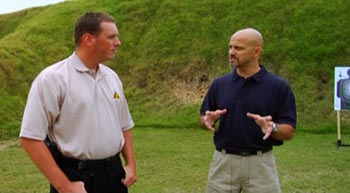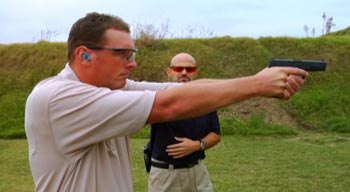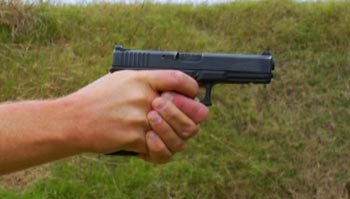Defensive Shooting Fundamentals
By Rob Pincus
 On the first episode of The Best defense, viewers saw Phil Strader and I working on the Extend, Touch, Press drill. This drill is the very first thing than anyone taking a Combat Focus Shooting course does on the range… regardless of their shooting background. I also think it is the best was to get someone started when they are first learning to shoot a handgun.
On the first episode of The Best defense, viewers saw Phil Strader and I working on the Extend, Touch, Press drill. This drill is the very first thing than anyone taking a Combat Focus Shooting course does on the range… regardless of their shooting background. I also think it is the best was to get someone started when they are first learning to shoot a handgun.
Fundamentals include the most basic aspects of the endeavor in question. When it comes to defensive shooting, there have undoubtedly been hundreds of essays and articles, even whole books, written on the fundamentals of defensive shooting. In order to cut the chase of what is really a the heart of defensive shooting ability, I ask instructor candidates in courses what they would tell someone if they only had 30 seconds to teach. To up the ante, I tell them to picture someone that they care about (an non-shooter) trapped in a room that a bad guy was going to break into in 30 seconds. The person has a loaded gun, but no knowledge about it.
As a contrast, think about how an experienced instructor might answer the following question: “What are the core components of a comprehensive training program designed for someone who doesn’t know anything about firearms and is interested in preparing to use one for self defense?”
The latter question is how most people approach the topic of defensive shooting fundamentals. There is no doubt that responsible firearms ownership includes a great deal more than simply being able to defend yourself with a loaded firearm from a bad guy coming through a doorway. Performing that task, however, is the core subject of this article and is the purpose of the ETP drill. In fact, I also think that these topics should be the first ones introduced in the comprehensive program, including ones meant for military and law enforcement personnel. Understanding the basics of Extend, Touch and Press will set the foundation for efficient firearms training and skill development for defensive use.
Body Position:
Over emphasizing a specific body position when you first start to shoot can cause long-term difficulties in flexibility and application of shooting skill in realistic situations. A position mirrors the body’s natural position immediately after being scared or startled is a perfect one for training defensive shooting skills. While other positions may offer more stability or even comfort, training in a way that is consistent with our bodies reactions in the worst case scenarios is important. Furthermore, the extra stability afforded by positions that take more time effort and energy to get into is rarely needed to support the accuracy requirements of typical defensive shooting. A good natural, neutral stance with the feet about shoulder width apart, knees slightly bent, shoulders forward of the hips with the body generally squared towards the target is the best way to practice your defensive shooting and is comprised of components that can be adjusted easily to accommodate a variety of plausible real world situations.
Extend:
 The first step in basic defensive shooting is extending the firearm in and parallel with your line of sight to the threat. Hand eye coordination is one of the first motor skills developed by human beings. Infants, with mediocre vision and poor spatial relationship abilities don’t realize that they can’t reach objects outside the length of their arms but still in their field of vision. The act of reaching towards something (a bottle, for example) places the hand in the line of sight to the to the object and eventually, as spatial awareness and the cause-effect relationship develops, this action turns into pointing, which facilitates mom bringing the bottle to the baby. The reward being significant, the behavior is encouraged and the skill development is rapid and long lasting. Pointing is one of our most basic human abilities and it is best done in the line of sight. The most intuitive position in which to shoot a firearm is in and parallel with the line of sight towards the threat.
The first step in basic defensive shooting is extending the firearm in and parallel with your line of sight to the threat. Hand eye coordination is one of the first motor skills developed by human beings. Infants, with mediocre vision and poor spatial relationship abilities don’t realize that they can’t reach objects outside the length of their arms but still in their field of vision. The act of reaching towards something (a bottle, for example) places the hand in the line of sight to the to the object and eventually, as spatial awareness and the cause-effect relationship develops, this action turns into pointing, which facilitates mom bringing the bottle to the baby. The reward being significant, the behavior is encouraged and the skill development is rapid and long lasting. Pointing is one of our most basic human abilities and it is best done in the line of sight. The most intuitive position in which to shoot a firearm is in and parallel with the line of sight towards the threat.
Extending the gun fully is also an important part of efficient defensive shooting in order to quickly develop a consistent ability to place shots and manage recoil.
Touch & Press:
The next two steps are ones that will quickly become one intuitive step for almost all shooters. When first learning to shoot, however, separating these two physically and mentally will help to develop good trigger control and lessen the amount deviation from the intended point of impact introduced during the shooting process. Good trigger control is probably the one consistently required mechanical portion of all shooting endeavors. With students on the range, we’ll check the body position and then give three separate commands.
 For most shooters, developing a feel for Extend, Touch and Press won’t take much time. Getting into a good position and then performing the By relying on simple intuitive motions and concepts, the ETP teaching process regularly results in students easily achieving good Combat Accurate hits at 10-12 feet within their first few shots.
For most shooters, developing a feel for Extend, Touch and Press won’t take much time. Getting into a good position and then performing the By relying on simple intuitive motions and concepts, the ETP teaching process regularly results in students easily achieving good Combat Accurate hits at 10-12 feet within their first few shots.
After achieving a few good hits, students should start putting all the pieces together more fluidly, with one command. Learning to Extend, Touch and Press smoothly and quickly might take a few more shots and then we’re ready to move to multiple shots. Multiple shots drive home the importance of keeping one’s weight forward and achieving full extension in order to maximize the ability to manage recoil. Training to shoot until the threat has stopped means not training to shoot a pattern of shots or a specific number of times. Usually, shooting 2 or 3 shots at a time creates enough variation and provides a fair number of strings of fire between reloads, even with a low capacity pistol or revolver.
Even if you only have 30 seconds, telling someone to extend the gun fully in and parallel with their line of sight and pressing the trigger smoothly while keeping their weight forward and focus on the center of the threat’s chest should prepare someone with enough information to defend themselves effectively in a worst case scenario when the bad guy comes through the door.
Keep watching The Best Defense on Outdoor Channel and keep your eyes open for “The Best Defense Book”, due out during 2009 featuring even more information from Mike Janich and I on the topics covered during the first season!
![]()
* BACK TO EPISODE 1 * DISCUSS THIS TOPIC ON THE FORUM *






